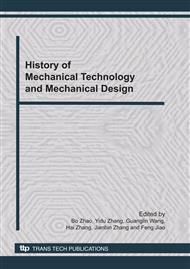[6]
(a) (b) (c) (d) (e) Fig. 5 Apple orientation information Among them, (a) and (b) shown successfully orientated apples, (c), (d) and (e) indicated failure ones. Apples orientated successfully were acquired direct images, whose boundary curve is the maximum cross section of the apple. It can be seen from fig. 7 that the boundary curve is similar to circle and the position of stem and calyx are near to centre of figure of the apple image. Apples failed to orientate can't meet the two points mentioned above. So, when the two factors are satisfied, the apple is considered to be orientated successfully. Results and Discussion A prototype sorter has been developed to test the system function of apple orientation, rotation, image capture and orientate judgment. Mechanical conveying system for apples is shown as fig. 5. The forward speed of trays is 0. 2m/s, the length of apple orientation area is 900mm, duration of validity for orientation is 4. 5s, the outer tray size is 100mm×105mm, the outer ring diameter of inner tray is 75mm, the inner ring diameter of inner tray is 35mm, the diameter of orientation wheel is 28. 6mm, rotating and friction pulley adopts =94°and they are taper round platforms up and down of the pulley with the diameters of 15mm and 22mm, the length of side reversal orbit is 600mm and the runtime of tray on it is 3s approximately. computer with Pentium IV as CPU and 3. 0G as basic frequency, Matsushita camera GP470 and image capture card of ok-30 are used for these experiments. Experiment for Apple Location. The rotate speed of the individual tray orientation wheel is 300r. p. m and orientation time is 4s, which tests orientation effects of orientation device. Fuji apples were used as experimental objects, selected 20 ones respectively with the diameters of less than 70mm, 70-80mm, 80-90mm and more than 90mm. These apples were feed into conveying device at random. 76 apples orientated within 4s, 4 failed. Reasons for failure are: a) the outer shape of apples was strange, and there were certain hollows on the side surface, b) apples with diameter less than 65mm were too small that they failed to orientate, for the hollows in the stem and calyx area were not fully complied with the middle part of the tray. Experiment of Apple Rotating with Same Angular Speed but Different Diameter. 3 apples sized 70mm, 80mm and 90mm were selected for this experiment. Every apple surface was divided into 4 parts by line from stem to calyx, and every part was marked 1', '2', '3' and '4, separately. These apples were feed into apple conveying device, and were conveyed to image capture area after orientation, where apple images were captured by the camera installed slanting upward side of the tray of 45° at the interval of about 0. 66s. Fig. 8 shown the 4 original continuous pictures for the three apples, each one rotated about 1 circuit in the field of camera view, and the same rotating angels in the same time interval. Therefore, the requirement of rotating apples with the same angular speeds and different diameters was basically attained in this mechanism. Experiment for Image Capture. Camera 1 and 2 acquired apple images respectively by the triggering of sensors. The diameter and position of stem or calyx of apples acquired by apple top image which were shown in Fig. 5 were processed, and could be used for identifying apple orientated or not orientated quickly. 4 side surface images information for single apple were shown in fig. 8. Experiment indicated that image capture met the pro-plan. Experiment for Apple Orientation Judgment. Image information acquired by camera 1 was processed and decided whether apples were orientated or not. 50 images were processed, 2 were miss judged, which resulted from apple abnormality. Conclusions The design of the system made it possible that different diameter apples rotate at the same angular speed while in conveying procedure, and be orientated automatically. Orientation judgment part was added in this system, which facilitates following tests of attributes, help to get higher testing precision and lower difficulty for image information processing. 2 cameras were used in the system for acquiring apple surface information, inspecting apple outer quality according to 1 direct image and 4 side images, and getting more complete and precise information, and the capture of side surface image information turned aside stem and calyx, avoided distinguishing among stem, calyx and error, though integrity of the system test remains to further study. Referance.
Google Scholar
[1]
Q.H. Zhou, D.X. Zhang: Journal of China Agricultural University, Vol. 10 (2005) No. 5, pp.36-39 (In Chinese).
Google Scholar
[2]
J.A. Throop, D.J. Aneshansley: ASAE Paper, No. 036123: 1-13(2003).
Google Scholar
[3]
J.A. Throop, D. J. Aneshansley, et al.: ASAE Paper, No. 036161: 1-21(2003).
Google Scholar
[4]
J. Ling, D.X. Zhang and B. Liu: Transactions of the Chinese Society for Agricultural Machinery, Vol. 40 (2009) No. 5, pp.158-161(In Chinese).
Google Scholar
[5]
Y.B. Ying, X.Q. Rao, Y.L. Huang, et al.: Transactions of the Chinese Society for Agricultural Machinery, Vol. 35 (2004) No. 3, pp.179-180, 183 (In Chinese).
Google Scholar
[6]
V. Leemans, M. -F. Destain: Journal of Food Engineering, Vol. 61(2004) No. 1, pp.83-89.
Google Scholar


